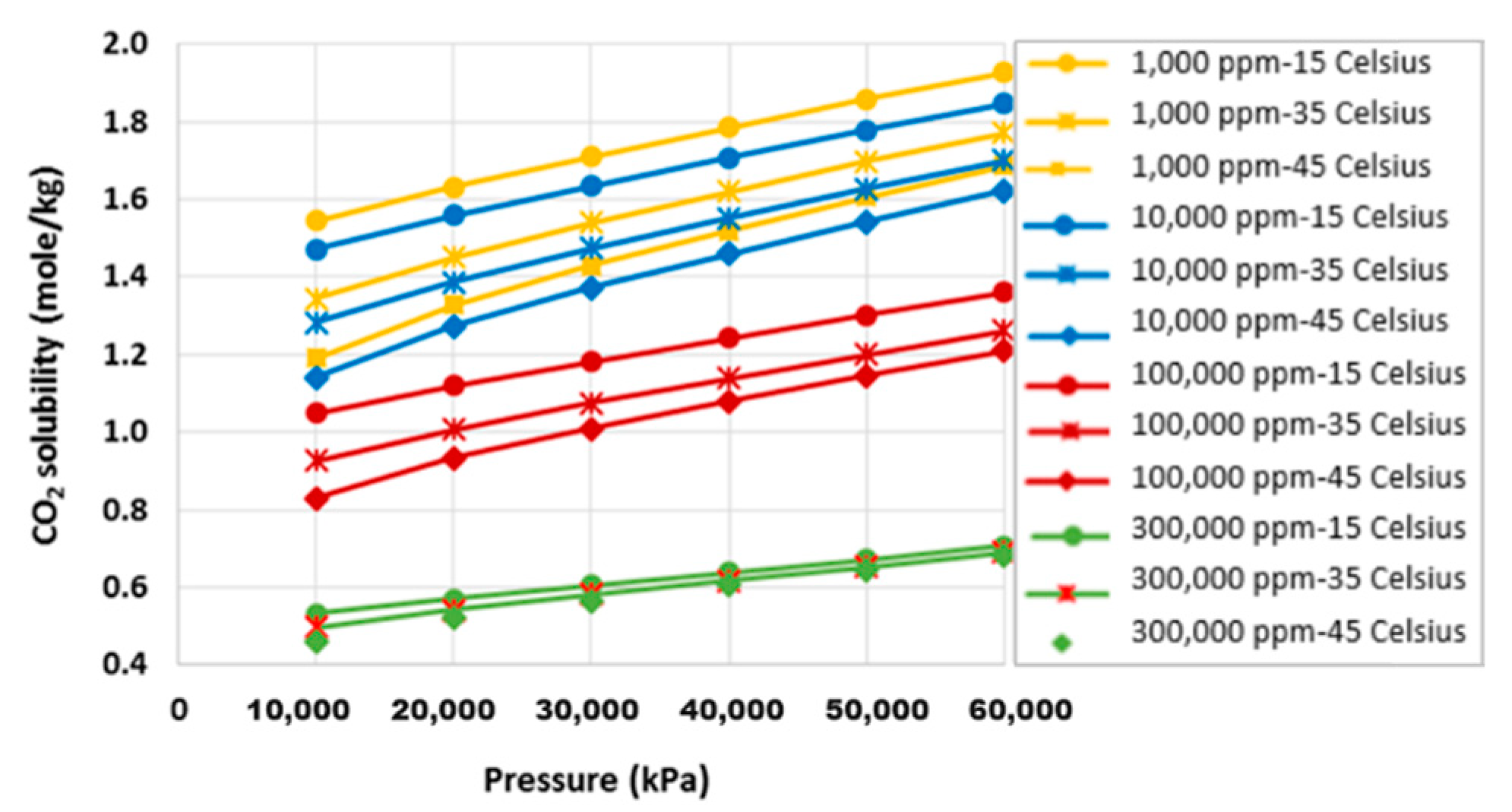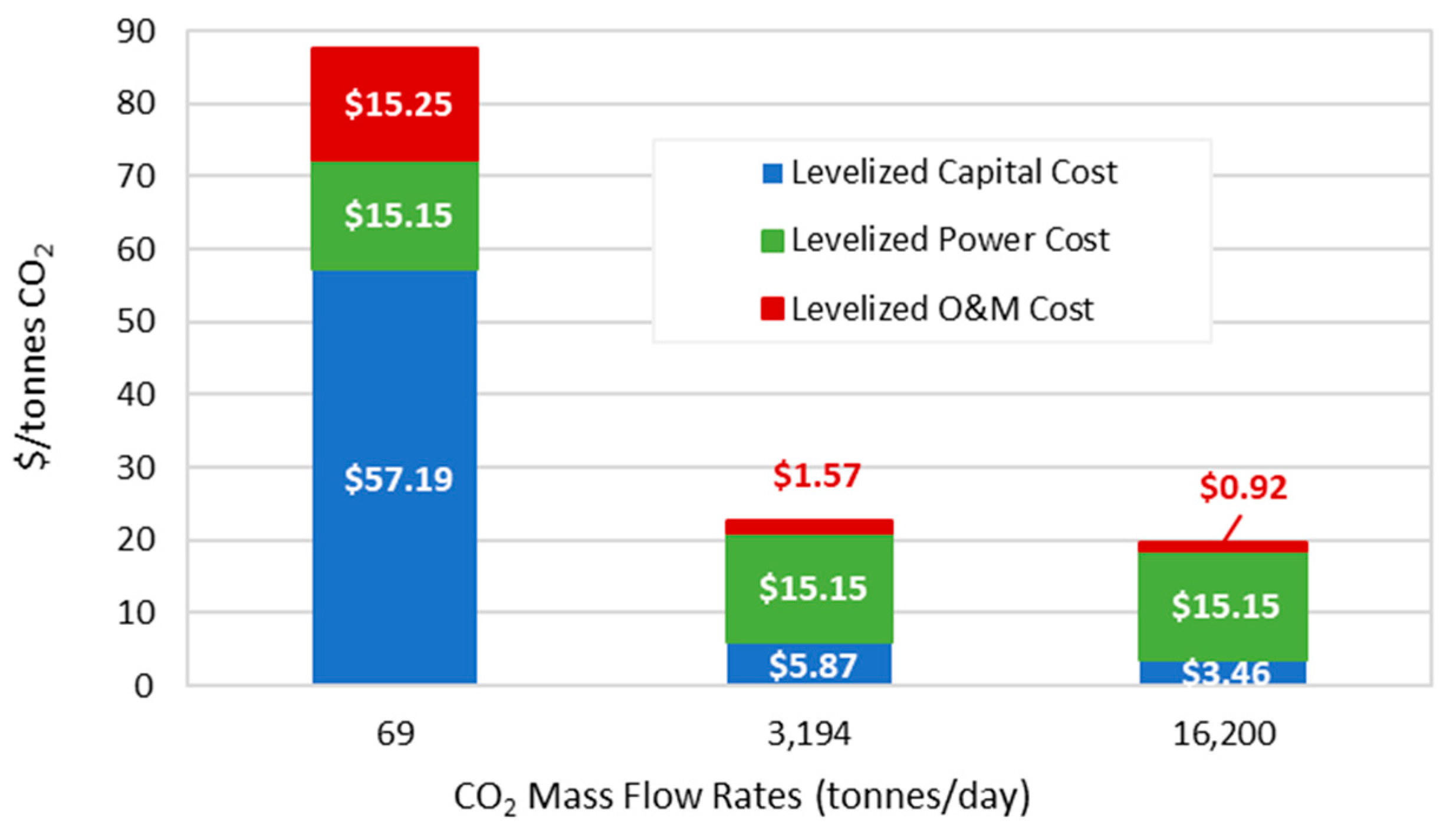Carbon Storage Potential of North American Oil & Gas Produced Water Injection with Surface Dissolution
Abstract
:1. Introduction
2. Economic Analysis
2.1. Surface Dissolution
2.2. Compression Cost
2.3. Transportation Cost
3. Economic Analysis
4. Conclusions
Author Contributions
Funding
Data Availability Statement
Acknowledgments
Conflicts of Interest
References
- IPCC. IPCC Special Report on Carbon Dioxide Capture and Storage. Prepared by Working Group III of the Intergovernmental Panel on Climate Change; Cambridge University Press: Cambridge, UK; New York, NY, USA, 2005; 442p. [Google Scholar]
- Hitchon, B.; Gunter, W.; Gentzis, T. The Serendipitous Association of Sedimentary Basins and Greenhouse Gases; American Chemical Society, Division of Fuel Chemistry: Washington, DC, USA, 1996; Volume 41, pp. 1428–1432. [Google Scholar]
- Khan, C.; Ge, L.; Rudolph, V. Reservoir Simulation Study for CO2 Sequestration in Saline Aquifers. Int. J. Appl. Sci. Technol. 2015, 5, 30–45. [Google Scholar]
- U.S. Geological Survey Geologic Carbon Dioxide Storage Resources Assessment Team. 2013a, National Assessment of Geologic Carbon Dioxide Storage Resources—Data: U.S. Geological Survey Data Series 774, 13 p., Plus 2 Appendixes and 2 Large Tables in Separate Files. Available online: http://pubs.usgs.gov/ds/774/ (accessed on 15 March 2018).
- Prevost, H.; Fuller, R.; Altevogt, A.; Bruant, R.; Scherer, G. Numerical modelling of carbon dioxide injection and transport in deep saline aquifers. Greenh. Gas Control Technol. 2005, 11, 2189–2193. [Google Scholar]
- Bennion, B.; Bachu, S. Supercritical CO2 and H2S—Brine drainage and imbibition relative permeability relationships for intercrystallite sandstone and carbonate formations. In Proceedings of the SPE Europec/EAGE Annual Conference and Exhibition, Vienna, Austria, 12–15 June 2006. SPE 99326. [Google Scholar]
- Benson, S.; Pini, R.; Calvo, R.; Niemi, A. Relative Permeability for Multi-Phase Flow in CO2 Storage Reservoirs. Part II: Resolving Fundamental Issues and Filling Data Gaps; Global CCS Institute: Melbourne, Australia; Stanford University: Stanford, CA, USA, 2015. [Google Scholar]
- Benson, S.; Pini, R.; Reynolds, C.; Krevor, M. Relative Permeability Analysis to Describe Multiphase Flow in CO2 Storage Reservoirs; Report No.2; Global CCS Institute: Melbourne, Australia; Stanford University: Stanford, CA, USA, 2013. [Google Scholar]
- Gaspar, A.; Lima, G.; Suslick, S. CO2 capture and storage in mature oil reservoir: Physical description, EOR and economic evaluation of a case of a Brazilian mature field. In Proceedings of the SPE Europe/EAGE Annual Conference, Madrid, Spain, 13–16 June 2005. SPE 94181. [Google Scholar]
- Bachu, S. CO2 storage in geological media: Role, means, status and barriers to deployment. Prog. Energy Combust. Sci. 2008, 34, 254–273. [Google Scholar] [CrossRef]
- Burton, M.; Bryant, S. Eliminating buoyant migration of sequestered CO2 through surface dissolution: Implementation costs and technical challenges. SPE Reserv. Eval. Eng. 2009, 12, 399–407. [Google Scholar] [CrossRef]
- Eke, P.; Naylor, M.; Haszeldine, S.; Curtis, A. CO2-Brine surface dissolution and injection: CO2 storage enhancement. In Proceedings of the SPE Offshore Europe Oil and Gas Conference and Exhibition, Aberdeen, UK, 8–11 September 2009. SPE 124700. [Google Scholar]
- Tao, Q.; Bryant, S. Optimal control of injection/extraction wells for the surface dissolution CO2 storage strategy. In Proceedings of the Carbon Management Technology Conference, Orlando, FL, USA, 7–9 February 2012. SPE 151370. [Google Scholar]
- Nghiem, L.; Shrivastava, V.; Kohse, B. Modelling aqueous phase behavior and chemical reactions in compositional simulation. In Proceedings of the SPE Reservoir Simulation Symposium, Woodlands, TX, USA, 21–23 February 2011. SPE Paper 141417. [Google Scholar]
- Clark, C.; Veil, J. Produced Water Volumes and Management Practices in the United State; Report for U.S. Department of Energy, Office of Fossil Energy, National Energy Technology Laboratory: Washington, DC, USA, 2009. [Google Scholar]
- Veil, J. Produced Water Volumes and Management Practices in 2012; Report for the Groundwater Protection Council; Veil Environmental, LLC.: Annapolis, MD, USA, 2015. [Google Scholar]
- Fossil Water. Scoping Study: Produced Water Beneficial Re-Use–High TDS Waters; Report for PTAC; Government of Alberta: Edmonton, AB, Canada, 2007. [Google Scholar]
- Bachu, S.; Melnikb, A.; Bistrana, R. Approach to evaluating the CO2 storage capacity in Devonian deep saline aquifers for emissions from oil sands operations in the Athabasca area, Canada. Energy Procedia 2014, 63, 5093–5102. [Google Scholar] [CrossRef] [Green Version]
- Ghaderi, S.; Leonenko, Y. Reservoir modeling for Wabamun lake sequestration project. Collect. Energy Sci. Eng. 2017, 3, 98–114. [Google Scholar] [CrossRef]
- Zhao, H.; Fedkin, M.V.; Dilmore, R.M.; Lvov, S.N. Carbon dioxide solubility in aqueous solutions of sodium chloride at geological conditions: Experimental results at 323.15, 373.15, and 423.15 K and 150 bar and modeling up to 573.15 K and 2000 bar. Geochim. Cosmochim. Acta. 2015, 149, 165–189. [Google Scholar] [CrossRef] [Green Version]
- Mao, S.; Zhang, D.; Li, Y.; Liu, N. An improved model for calculating CO2 solubility in aqueous NaCl solutions and the application to CO2–H2O–NaCl fluid inclusions. Chem. Geol. 2013, 347, 43–58. [Google Scholar] [CrossRef]
- Duan, Z.; Sun, R. An improved model calculating CO2 solubility in pure water and aqueous NaCl solutions from 273 to 533 K and from 0 to 2000 bar. Chem. Geol. 2003, 193, 257–271. [Google Scholar] [CrossRef]
- Hangx, S. Behaviour of the CO2-H2O System and Preliminary Mineralisation Model and Experiments; HPT Laboratory, Department of Earth Sciences Utrecht University: Utrecht, The Netherlands, 2005. [Google Scholar]
- McCollum, D.; Ogden, J.M. Techno-Economic Models for Carbon Dioxide Compression, Transport, and Storage and Correlations for Estimating Carbon Dioxide Density and Viscosity; Institute of Transportation Studies, University of California: Davis, CA, USA, 2006. [Google Scholar]
- Dawson, G.; Biddle, D.; Farquhar, S.; Golding, S.; Jiang, X.; Keck, R.; Khan, C.; Law, A.; Li, Q.; Pearce, J.; et al. Geochemical and Geomechanical Testing of Near Wellbore CO2 Injectivity Improvement; ANLEC. Project 7-1110-0101; The University of Queensland: Brisbane, Australia, 2014. [Google Scholar]





| Field Name | Volumes m3/Year | Injection Wells |
|---|---|---|
| Alabama | 4,584,938 | 83 |
| Alaska | 10,095,110 | 64 |
| Arkansas | 16,845,018 | 640 |
| California | 74,288,290 | 970 |
| Colorado | 14,772,648 | 292 |
| Florida | 1,784,466 | 7 |
| Indiana | 1,714,328 | 208 |
| Kansas | 93,570,453 | 3523 |
| Louisiana | 102,238,847 | 3231 |
| Michigan | 11,924,047 | 710 |
| Mississippi | 12,407,716 | 494 |
| Montana | 6,741,390 | no data |
| Nebraska | 2,236,986 | 113 |
| Nevada | 565,538 | 10 |
| New Mexico | 45,449,739 | no data |
| North Dakota | 19,314,300 | 350 |
| South Dakota | 270,841 | 15 |
| Ohio | 1,688,193 | 190 |
| Oklahoma | 129,623,927 | 4021 |
| Pennsylvania | 503,198 | no data |
| Utah | 10,199,134 | 118 |
| West Virginia | 462,171 | 64 |
| Virginia | 385,327 | 4879 |
| Wyoming | 37,315,578 | 335 |
| Total | 598,982,186 | 20,317 |
| Field Name | Volume m3/Year | Injection Wells |
|---|---|---|
| Provost | 22,100,000 | 130 |
| Redwater | 20,900,000 | 50 |
| Hayter | 19,200,000 | 35 |
| Grand Forks | 16,700,000 | 63 |
| Bellshill Lake | 15,600,000 | 19 |
| Jenner | 14,400,000 | 19 |
| Bow Island | 13,500,000 | 27 |
| Bantry | 12,600,000 | 28 |
| Enchant | 12,200,000 | 22 |
| Killam | 11,600,000 | 13 |
| Rainbow | 10,800,000 | 16 |
| Taber North | 9,420,000 | 27 |
| Taber | 8,870,000 | 24 |
| Fenn-Big Valley | 8,340,000 | 18 |
| Hays | 5,970,000 | 14 |
| Lindbergh | 5,170,000 | 14 |
| Mitsue | 4,330,000 | 10 |
| Fort Saskatchewan | 3,400,000 | 3 |
| Sturgeon Lake | 377,000 | 8 |
| Total | 215,477,000 | 130 |
Publisher’s Note: MDPI stays neutral with regard to jurisdictional claims in published maps and institutional affiliations. |
© 2021 by the authors. Licensee MDPI, Basel, Switzerland. This article is an open access article distributed under the terms and conditions of the Creative Commons Attribution (CC BY) license (http://creativecommons.org/licenses/by/4.0/).
Share and Cite
Khan, C.; Pearce, J.K.; Golding, S.D.; Rudolph, V.; Underschultz, J.R. Carbon Storage Potential of North American Oil & Gas Produced Water Injection with Surface Dissolution. Geosciences 2021, 11, 123. https://doi.org/10.3390/geosciences11030123
Khan C, Pearce JK, Golding SD, Rudolph V, Underschultz JR. Carbon Storage Potential of North American Oil & Gas Produced Water Injection with Surface Dissolution. Geosciences. 2021; 11(3):123. https://doi.org/10.3390/geosciences11030123
Chicago/Turabian StyleKhan, Chawarwan, Julie K. Pearce, Suzanne D. Golding, Victor Rudolph, and Jim R. Underschultz. 2021. "Carbon Storage Potential of North American Oil & Gas Produced Water Injection with Surface Dissolution" Geosciences 11, no. 3: 123. https://doi.org/10.3390/geosciences11030123
APA StyleKhan, C., Pearce, J. K., Golding, S. D., Rudolph, V., & Underschultz, J. R. (2021). Carbon Storage Potential of North American Oil & Gas Produced Water Injection with Surface Dissolution. Geosciences, 11(3), 123. https://doi.org/10.3390/geosciences11030123








